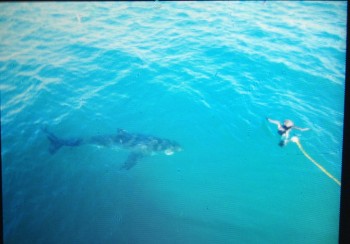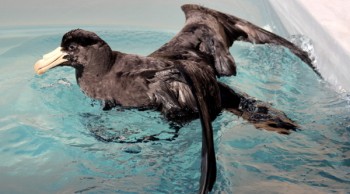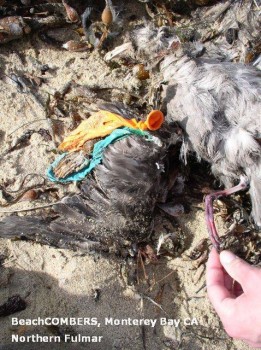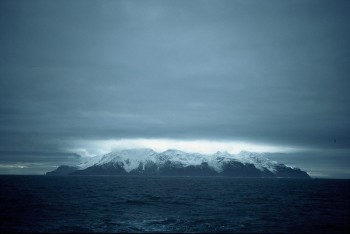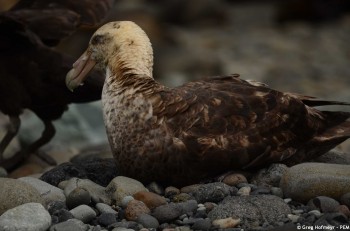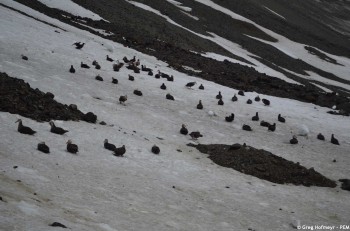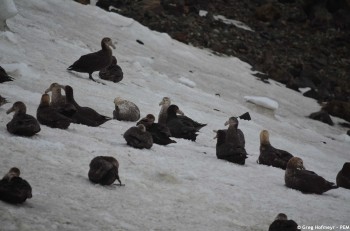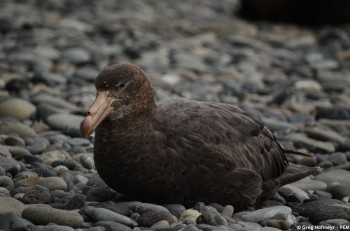A workshop held earlier this year by the American Bird Conservancy and BirdLife International in the USA discussed methods of reducing non-target bycatch in gill nets. “The main objectives of the workshop were to identify possible gillnet bycatch reduction methods that could be effective across taxonomic groups (seabirds, sea turtles, and sea mammals) and produce specific projects and plans for testing those methods.”
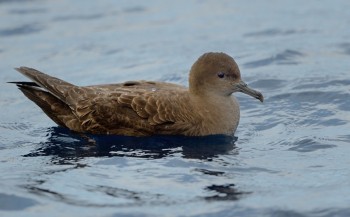
Shearwaters, like this Short-tailed, are at risk to drowning in gill nets, photograph by Kirk Zufelt
The report’s Executive Summary follows:
“The focus of the workshop was on technical methods of bycatch reduction of sea turtles, seabirds, and sea mammals in gillnets. The workshop was carried out 21-23 January 2015 with 35 participants from seven countries and 17 organizations, representing collective expertise from fishermen, academia, government employees, and conservation Non-Governmental Organizations (NGOs). The workshop objectives were to identify proposed gillnet bycatch mitigation methods, develop plans for trialing those methods, estimate the costs of trials, and identify teams who would work to carry out the trials. The workshop began with a series of presentations to provide background for the discussions to follow. This included presentations on where gillnet bycatch is known to occur; on the factors that influence bycatch probability; on the sensory abilities of the bycatch species to detect various potential mitigation methods; and on the results of previous workshops on gillnet bycatch reduction. Presentations also described bycatch reduction methods now being trialed, and gave a case study of successful technical mitigation for seabirds in the US Pacific Northwest. Workshop subgroups proposed bycatch reduction methods that can be placed into two categories:
- Active methods, including net lights and pingers in various configurations.
- Passive methods, such as high-contrast panels placed within nets, streamers, or colored nets or portions of nets.
To encourage industry support for such measures, a key aspect of all proposed methods was that they should maintain the level of target catch, to the extent possible, while reducing bycatch. Based on the proposed mitigation methods, workshop subgroups proposed a set of trial projects. For each project or set of projects, a region was identified where the project could be carried out, ensuring:
- Adequate bycatch levels to detect the efficacy of mitigation measures.
- The necessary infrastructure and partners present to carry out trials.
- Representation across the taxa groups.
- Good prospects of financial support for the project.
Key actors and leaders were identified for each project. The proposed projects fell into five regional groupings:
- North Pacific: With a focus on seabird bycatch (particularly alcids) in salmon driftnets, trials of net striping, pingers, high-visibility sections, and dropped headlines were proposed. A specific North Pacific salmon driftnet workshop was suggested, to examine common approaches to bycatch mitigation.
- Northwest Atlantic: The workshop proposed trials of net lights, double-weighted lead lines, colored nets, and high-visibility sections in Newfoundland gillnet fisheries, where there are already strong connections between fishermen, academics, NGOs and management authorities. The focus here would be on seabirds, porpoises, and pinnipeds. Sea turtle-focused projects testing low-profile nets were proposed off the US east coast.
- Northeast Atlantic: The group recommended trials of net lights and high-visibility panels placed in nets on the south coast of England to look at effects on cetaceans and proposed trials of the same methods in the Baltic Sea, focusing on sea duck bycatch (ongoing work by BirdLife International (BLI) in Lithuania, potentially some new work in Latvia or Germany).
- South America: In Chile, where seabird (penguins and shearwaters in particular), sea turtle, and cetacean bycatch is of particular concern, the group proposed the continuation of a project on high-visibility net panels being led by the Albatross Task Force (ATF). In Peru, the continuation of mitigation projects testing net lights and subsurface nets for reduction of bycatch of sea turtles, seabirds, and sea mammals, led by ProDelphinus working with various partners, was proposed. The workshop groups noted that southern Brazil is an important to place to link with existing projects and partners to improve understanding of the visual capacities of target and bycatch species. In addition, a laboratory project on seabird underwater hearing capacity was proposed, but not at a specific site. The tests would need to be carried out at a research facility with access to captive live birds and large seawater tanks, such as the US Geological Surveys (USGS) Patuxent Wildlife Research Center (Maryland, USA) or one of the large aquariums. The crucial next steps following the workshop are to push forward the proposed projects, seeking financing and support of various partners and stakeholder groups. In addition, it is clearly necessary to gain a deeper understanding of how marine mammals, seabirds, and sea turtles interact with gillnets. Although this can be difficult because of the nature of the fisheries, it will be crucial in informing the design of mitigation measures. Participants agreed that information sharing on best practice and lessons learned across projects is [are] very important, something the workshop organizers will seek to facilitate.”
With thanks to Barry Baker, Rory Crawford and David Wiedenfeld for information.
Reference:
Wiedenfeld, D.A., Crawford, R. & Pott, C.M. 2015. Results of a Workshop on Reduction of Bycatch of Seabirds, Sea Turtles, and Sea Mammals in Gillnets. National Conservation Training Center Shepherdstown, West Virginia, USA, 21-23 January 2015. American Bird Conservancy & BirdLife International. pp. 36.
John Cooper, ACAP Information Officer, 19 April 2015

 English
English  Français
Français  Español
Español 